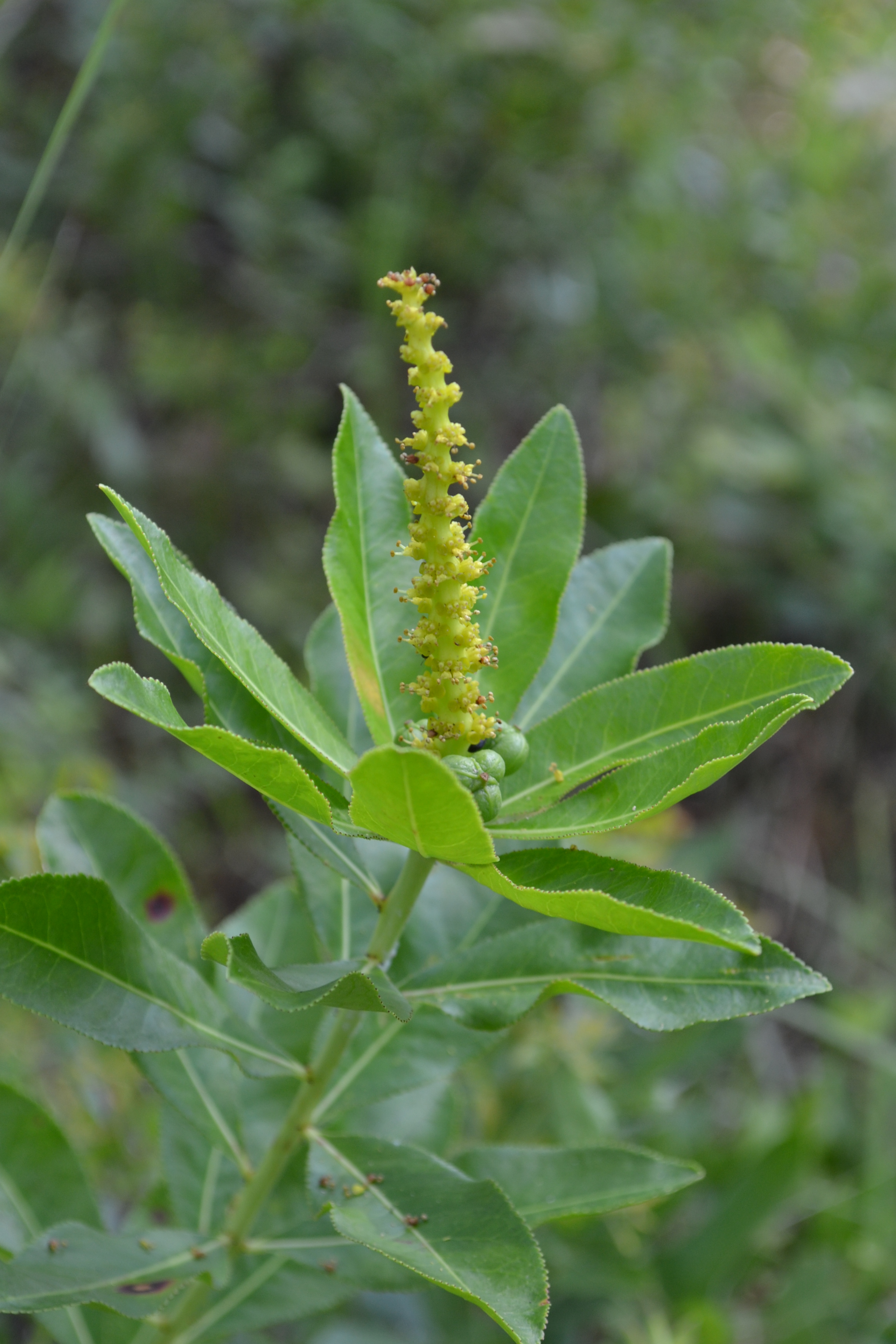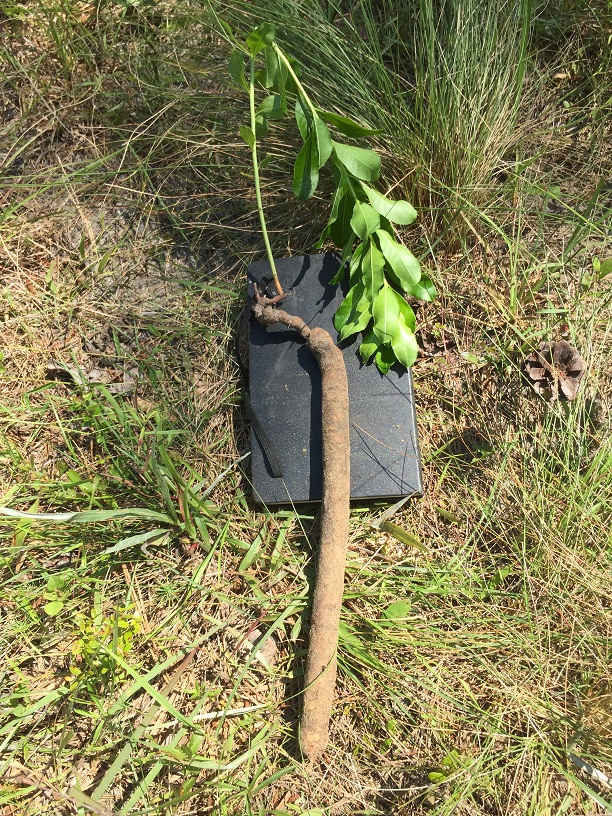Difference between revisions of "Stillingia sylvatica"
(→Photo Gallery) |
(→Taxonomic notes) |
||
| Line 20: | Line 20: | ||
Common name: queen's-delight | Common name: queen's-delight | ||
==Taxonomic notes== | ==Taxonomic notes== | ||
| + | Synonyms: ''Stillingia sylvatica'' var. ''sylvatica''; ''S. sylvatica'' ssp. ''sylvatica''; ''S. spathulata'' | ||
| + | (Müller of Aargau) Small | ||
| + | |||
==Description== | ==Description== | ||
<!-- Basic life history facts such as annual/perrenial, monoecious/dioecious, root morphology, seed type, etc. --> | <!-- Basic life history facts such as annual/perrenial, monoecious/dioecious, root morphology, seed type, etc. --> | ||
Revision as of 20:01, 5 May 2016
| Stillingia sylvatica | |
|---|---|

| |
| Photo taken by Michelle M. Smith | |
| Scientific classification | |
| Kingdom: | Plantae |
| Division: | Magnoliophyta – Flowering plants |
| Class: | Magnoliopsida – Dicotyledons |
| Order: | Euphorbiales |
| Family: | Euphorbiaceae |
| Genus: | Stillingia |
| Species: | S. sylvatica |
| Binomial name | |
| Stillingia sylvatica L. | |

| |
| Natural range of Stillingia sylvatica from USDA NRCS Plants Database. | |
Common name: queen's-delight
Contents
Taxonomic notes
Synonyms: Stillingia sylvatica var. sylvatica; S. sylvatica ssp. sylvatica; S. spathulata (Müller of Aargau) Small
Description
"Glabrous, monoecious, perennial herbs or shrubs with alternate leaves. Leaves finely crenate, the teeth with pointed, callous spicules, sessile or short-petiolate. Spike terminal, rachis with numerous large glands, the lower portion pistillate flowered, the upper staminate. Calyx 2-3 parted, yellow; petals none; stamens 2; stigmas 3, red. Capsules as long as broad, leaving a 3-lobed disc upon falling from plant. Seeds grayish white, ovoid; caruncle small." [1]
"Herbaceous perennial, to 8 dm tall, with few to numerous stems arising from a crown; stems branching only immediately below an inflorescence with 2-4 branches. These usually terminated in an inflorescence. Leaves elliptic, 3.5-9 cm long, 1-4.5 cm wide; petioles 0-4 mm long, base glandular-stipulate. Spike 5-12 cm long. Capsules 8-10 mm long. Seeds nearly smooth, 5-6 mm long." [1]
Distribution
Ecology
Habitat
In the Coastal Plain in Florida and Georgia, S. sylvatica can be found in sandhills (FSU Herbarium; [2]), pine flatwoods, open pine-oak woodlands, recently burned pine-oak scrubs, longleaf pine-wiregrass stands, longleaf pine-turkey oak-wiregrass, and annually burned pinelands (FSU Herbarium). Substrate types include loamy sand, sand (FSU Herbarium), and siliceous, hypothermic Ultic haplaquod of the Pomona series. [3]
Associated species include Stillingia aquatica, Phlox floridana, Asimina longifolia var. spathulata, Lactuca graminifolia, Pterocaulon undulatum, Asclepias humistrata and Quercus hemisphaerica (FSU Herbarium).
Phenology
It has been observed flowering April through July (FSU Herbarium).
Seed dispersal
It is dispersed explosively (up to 3 meters); seeds are forcefully expelled after the fruit matures and dries. It can also be dispersed by ants. [2] According to Kay Kirkman, a plant ecologist, this species disperses by explosion mechanisms or by ants. [4]
Seed bank and germination
Fire ecology
It seems to respond positively to burning. In an experiment by Greenberg (2003), and he noted that the percent cover of S. sylvatica was highest 16 months after a May burn. [5]
Pollination
Use by animals
The seeds of S. sylvatica contain elaiosomes and have been found in middens of Florida harvester ants, Pogonomyrmex badius. [2]
Diseases and parasites
Conservation and Management
Cultivation and restoration
Photo Gallery
References and notes
Florida State University Robert K. Godfrey Herbarium database. URL: http://herbarium.bio.fsu.edu. Last accessed: July 2015. Collectors: Bian Tan, Ann F. Johnson, Loran C. Anderson, Helen Roth, R. A. Norris, Robert K. Godfrey, M. Davis, Cecil R Slaughter, Annie Schmidt. States and Counties: Florida: Alachua, Charlotte, Duval, Franklin, Gadsden, Leon, Nassau, Wakulla, Washington. Georgia: Thomas. Compiled by Tall Timbers Research Station and Land Conservancy.
- ↑ 1.0 1.1 Radford, Albert E., Harry E. Ahles, and C. Ritchie Bell. Manual of the Vascular Flora of the Carolinas. 1964, 1968. The University of North Carolina Press. 667. Print.
- ↑ 2.0 2.1 2.2 Stamp, N. E. and J. R. Lucas. 1990. Spatial patterns and dispersal distances of explosively dispersing plants in Florida sandhill vegetation. Journal of Ecology 78:589-600.
- ↑ Moore, W. H., B. F. Swindel and W. S. Terry. 1982. Vegetative response to prescribed fire in a north Florida flatwoods forest. Journal of Range Management 35:386-389.
- ↑ Kay Kirkman, unpublished data, 2015.
- ↑ Greenberg, C. H. 2003. Vegetation recovery and stand structure following a prescribed stand-replacement burn in sand pine scrub. Natural Areas Journal 23:141-151.
